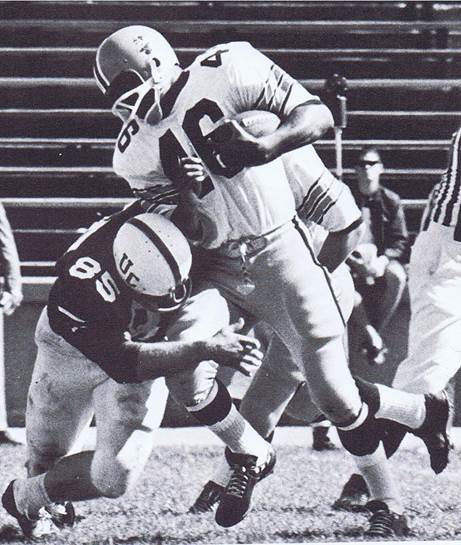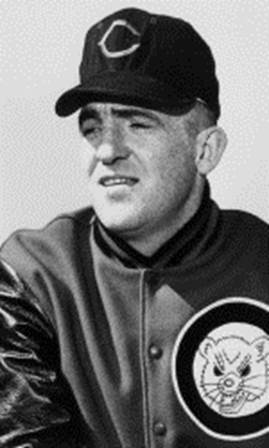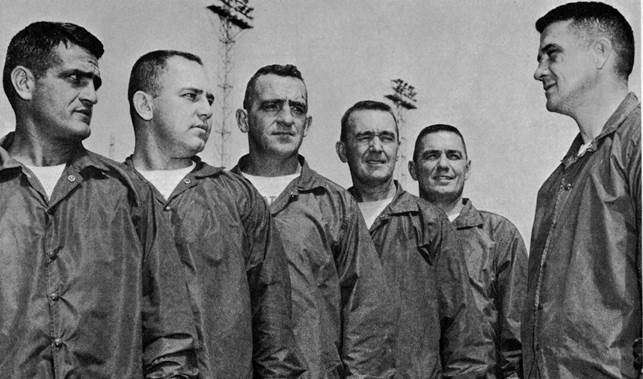

THEY USED TO CALL IT FOOTBALL, PART ONE
HELMET HUT NEWS/REFLECTIONS September 2015:
THEY USED TO CALL IT FOOTBALL, PART ONE
By Dr. Ken
The suspension helmet era in
football is generally considered
to span from the years of
approximately 1945 through the
beginning of the 1980’s.
Technically, that may not be
correct, with the Riddell
suspension helmet developed in
1939 and the various individual
“cell type” internal protection
helmets having widespread use by
the mid-‘70’s. However, it
wasn’t until the mid-1940’s that
full teams would be equipped
with the Riddell RT suspension
helmets on a regular basis and
there were many players with
lengthy careers who wore their
trusty RK or TK suspension
models deep into the Seventies
and some into the early 1980’s.
During that time period, the
specific offensive and defensive
philosophies and formations
changed, and alterations in the
equipment worn and rules of the
game followed to accommodate
those changes. However, the
fundamental purpose of football
remained and the emphasis was on
“the physical,” the dynamic that
allowed players and fans of one
distinct era to relate to those
from other eras. Now, it is
different, everything is
different. Every football fan
who reads the material or
browses the many helmets on our
HELMET HUT
site is interested enough in
football to know that on every
level of play, the game is not
the game that was played in the
1950’s through the late-1970’s
or early ‘80’s.
 |
Throughout the 1950 – 1980 span of time, the emphasis in the sport of football was always placed upon blocking and tackling fundamentals. University of Cincinnati tough guy Jim Swanda learned the effective way to tackle “through” the opponent
When the forward pass was introduced to the game, purists were concerned about the demise of football as they knew it. Needless to state, the game became an improved version of its past: more excitement, more scoring, more entertaining and little dilution of the game’s fundamentals. The game was built upon the fundamentals of physically dominating others with blocking and tackling techniques. The proper application of the appropriate technique could allow a smaller and perhaps less imposing individual to defeat another in a one-on-one confrontation and because that possibility existed, the game was always worth watching. As a young high school coach, I annoyed some of the older coaches in our area with an oft-repeated statement I made to my players at the beginning of each season. In summary I said, “Fellows, we think of football as a team game and you certainly must operate as a team in order to successfully execute each play, but what we have is eleven individual match-ups. This makes football an ‘individual game’ too. If I can teach you how to win six or seven of those individual contests on each play, we will win as a team.” In truth, that was the game of football as I knew it and as it was taught by my high school and college coaches, almost to a man, veterans of military combat in World War II, the Korean War, or both. These men had lived through and understood survival situations and brought that sense of conflict, urgency, physical and mental toughness, and willingness to both physically and technically prepare for conflict. The conflict of football, then, was very much a one-on-one, man-to-man battle based on contact, that spanned sixty minutes. If this sounds too testosterone-drenched for the younger reader, this almost perfectly reflects the lack of understanding of the game “then,” versus what football is today.
HISTORICAL INSERT
 |
Typical of the way in which football was played from the late 1950’s through the 1960’s when I was of age to play it, were the men who coached the game during that period of time. Very much typical of these men was Richard MacPherson who was in every sense of the word, a “man’s man.” A product of Old Town, Maine, he played four years of football and basketball and two seasons of baseball in high school. His leadership ability stood out, combined with a toughness that reflected being one of twelve children who always had a variety of jobs to supplement the income of his father who worked as a plumber. He had excellent football ability but it was his leadership skills that earned the respect of his teammates. After attending Maine Maritime Academy, he left to enlist in the U.S. Air Force during the Korean War. Four years of military service and the GI Bill brought him to Springfield College with enhanced “command presence,” especially as a more mature student relative to his teammates, and he led as Co-Captain from his center and middle linebacker positions. His teams were exceptionally successful, with Dick calling defensive signals, a true coach on the field. One of Springfield’s assistant coaches noted Dick’s great leadership ability and stated that “he got such high respect from the team. He gave them a lot of confidence in those years.”
Mac became an assistant at Springfield upon his graduation and then served as a graduate assistant at the University of Illinois where Chuck Studley was an assistant coach. MacPherson moved to an assistant’s position at the University of Massachusetts, and helped to bring Studley in as the head coach there when a coaching change occurred. After a year at UMass Studley took the Cincinnati head job, calling for Mac to join him there as his defensive coach.
 |
Head Coach Chuck Studley on the far right, Defensive Coach Dick MacPherson in the middle, with the rest of the 1965 UC staff
Studley too was a military
veteran, a U.S. Navy
submarine torpedo operator
and at UC, their backgrounds
of discipline, organization,
and teamwork was reflected
in the way in which the
fundamentals were taught and
practiced. This was typical
of the times, and of course,
both men rose through the
coaching ranks, with Studley
eventually a defensive
coordinator for Super Bowl
teams with the Bengals and
Dolphins and the head coach
of the Houston Oilers, and
Coach Mac becoming a College
Football Hall of Fame member
after his years as the head
man at Syracuse. Although
Cincinnati has been
considered to be the first
major college to institute
the use of a gap defense
under Coach Mac and Studley,
it was less the innovative
approach to formation and
more the consistent emphasis
on blocking and tackling
that marked the success of
their squads.
Another maxim about the way
in which football used to be
played, was “It isn’t a game
for everyone.” I held great
respect for my teammates,
opponents, and every young
man that I had the privilege
to coach over a combined
eleven-year high school
coaching career, at two
schools. In “my day”
football was not a game for
everyone because if it was
practiced and played
correctly, one would have to
accept the fact that they
would be hit and have to hit
someone else every day. This
is what separated those that
played from those that did
not. There were terrific
athletes in every school
that excelled in other
sports but did not, or could
not play football. It just
“wasn’t for them” and
sometimes it wasn’t for them
in large part because they
did not want to be hit or in
turn, hit someone, every day
of practice and in every
game. Allow me to interject
that the author and the
entire staff of
HELMET HUT
agrees that the physical
safety and well-being of
every player is, and must be
the foremost consideration
in presenting every aspect
of the game. That however,
puts the following question
squarely in the forefront of
what must be addressed
regarding both the way in
which the game is played
relative to the “old days,”
and what is best regarding
player safety: “Is the new
game of football the way it
is played and practiced more
conducive to long term
injury and the production of
potential brain damage
compared to the way it used
to be?”
 |
Is the emphasis on playing “basketball on grass” with a desire to avoid basic blocking and tackling and instead try for the ESPN highlight-reel kill shot causing more injuries than it prevents? These most provocative questions have a number of concepts to be considered but there is a crying need for an unbiased study to determine for example, if the new National Football League Collective Bargaining Agreement ‘s dictums regarding allowable practice time, contact sessions, tackling and blocking rules, and voluntary versus mandatory training and preparation sessions are reducing or increasing player injury and potential long range damage
More Next Month